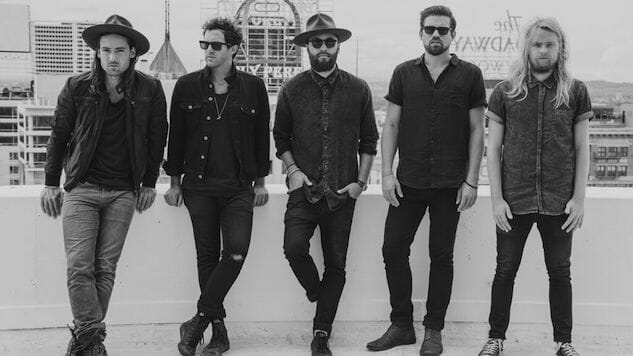Grizfolk: The Best of What’s Next

Every city has its legendary rock club where all the great acts played before they blew up, and in Nashville, that role is played by Exit/In. Little placards with painted-on names like “Red Hot Chili Peppers,” “Billy Joel” and “Talking Heads” coat the wall behind the bar all the way up to the ceiling. A DJ I know from my time at Nashville radio station Lightning 100 told me she once saw The Police play in front of 10 people on this stage. Last year, Uproxx even made a mini-documentary on the venue, hammering home the “Nashville isn’t all about country” angle that every local knows well.
I’m only a quasi-local—I graduated from Vanderbilt in May—but I did make myself familiar with Exit/In during my college tenure. And of every act I saw there, or really anywhere in the city, the one that surpassed my pre-show expectations the most was LA-based quintet Grizfolk. They were opening for Smallpools on the headliners’ “Lovetap” tour last April, but in my estimation (and in the review I wrote for my college radio station’s blog afterwards), the evening peaked with their performance. “Sounds like The Wild Feathers being kidnapped and forced to play dance-y music for hammered partygoers in Santa Monica but finding out they like it,” I thought at the time. Now, with Grizfolk’s debut album Waking Up The Giants newly released and a headlining tour planned for the next couple of months, their interesting hybrid of roots rock and electro-pop sheen is about to reach many more ears.
Unsurprisingly, the band’s style is born out of the combined musical backgrounds of its members. Lead singer Adam Roth provides the Americana, which stretches back to his childhood in Florida. “Growing up, my dad’s a doctor but he’s a blues guitarist and he practices his scales every day and he’s always jamming out to old blues records and stuff,” he said. Around age 13, the younger Roth traded his guitar for pen, paper, and a microphone and started writing songs and learning how to sing them—badly at first, but better with practice. Eventually, he found himself in Los Angeles majoring in art, where he had every musician’s vital realization.
“I was in a 3D design class, and it was the final project of the 3D design class and it was so difficult, and I know I could’ve done it but it was so time consuming,” he said. “So I was like, ‘Why am I in Los Angeles building a sculpture when I came out here to do music?’ That was the moment when I was like, I give up, I’m just gonna do music.”
Roth earned some opportunities to write songs for commercials, and it was on one of those assignments that he was teamed up with Swedish guitarist Fredrik Eriksson. Things worked out so well that they decided to write more songs together, but this time for themselves.
Meanwhile, another Swede, Sebastian Fritze, had moved to Los Angeles in search of a trip out of his comfort zone and a more diverse music community—Stockholm isn’t exactly known for hip-hop production. One of his roommates introduced him to Eriksson, who introduced him to Roth, whom Fritze realized that he already knew.
“The funny thing is that I was visiting LA two years prior to me moving out here and I saw Adam play at this speakeasy place, it was on the top floor of this place called The Stronghold in Venice,” he recalled. “And I saw him perform a solo type thing and I was like, oh, this guy has a great voice. And we talked a little bit after and exchanged info.”
The trio brought in Roth’s friends Brendan James on bass and Bill Delia on drums, and under the name Griz Adams (after the ‘70s outdoorsman), they started to play shows and record some songs. One of them, “The Struggle,” went viral in 2013, attracting the attention of a number of labels. By the end of that year, the band had adopted its current name and signed to Virgin Records without so much as a self-released EP. Initially, they had no idea how to handle their meteoric progress. “One of the people from the label put it like this: the best way to learn is to be thrown into it,” said Roth. “So that’s pretty much been the story of our lives: We don’t know what we’re doing, all of a sudden we’re just thrown into it and we gotta figure it out.”
One thing they had to figure out was how to build a strong support team, which fortunately came naturally. How to release their music was another matter. 2014 saw their debut studio EP, From the Spark, but it also saw a live EP called From the Road composed of tracks recorded on the band’s lengthy tour opening for Bastille (quite the rapid jump up from playing small clubs). After seeing them perform last April, it’s obvious to me why Grizfolk did this—their songs take on an entirely different character in concert. The studio versions’ heavy synths are toned down, replaced by spacious guitars and the impulse to rock out on them. Songs like “Bounty On My Head,” which isn’t even included on From the Spark, grow vast and moving.